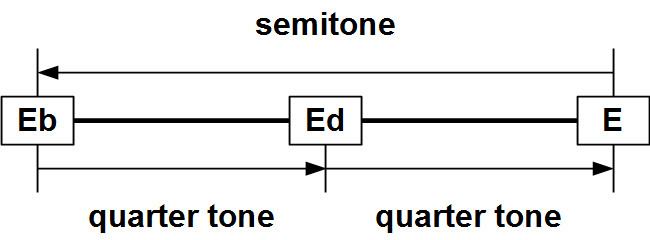Inverse neutral seventh Semitones ~1½ Just interval 11:10 or 12:11 | Abbreviation n2 Interval class ~1½ Equal temperament 100 or 200 | |
 | ||
In music theory, a neutral interval is an interval that is neither a major nor minor, but instead in between. For example, in equal temperament, a major third is 400 cents, a minor third is 300 cents, and a neutral third is 350 cents. A neutral interval inverts to a neutral interval. For example, the inverse of a neutral third is a neutral sixth.
Roughly, neutral intervals are a quarter tone sharp from minor intervals and a quarter tone flat from major intervals. In just intonation, as well as in tunings such as 31-ET, 41-ET, or 72-ET, which more closely approximate just intonation, the intervals are closer together.
A neutral second or medium second is an interval wider than a minor second and narrower than a major second. Three distinct intervals may be termed neutral seconds:
The equal-tempered neutral second may be found in the quarter tone scale and in some traditional Arab music (see also Arab tone system). Because neutral seconds are essentially a semitone (minor second) plus a quarter-tone, they may be considered three-quarter tones.
In equal temperament
Approximations to the 12:11 and 11:10 neutral seconds can be found in a number of equally tempered tuning systems. 11:10 is very closely matched by 22-ET, whereas 12:11 is matched by 24-ET, 31-ET and 41-ET. 72-ET matches both intervals closely and is also the smallest widely used equal temperament that uniquely matches both intervals. Tuning systems that temper out the comma of 121:120 do not distinguish between the two intervals. 17-ET has a neutral second between 12:11 and 13:12, and a neutral third between 16:13 and 11:9.
A neutral seventh is a musical interval wider than a minor seventh play but narrower than a major seventh play . Four distinct intervals may be termed neutral sevenths:
These intervals are all within about 12 cents of each other and are difficult for most people to distinguish.
A neutral seventh can be formed by stacking a neutral third together with a perfect fifth. Based on its positioning in the harmonic series, the undecimal neutral third implies a root one perfect fifth below the lower of the two notes.
